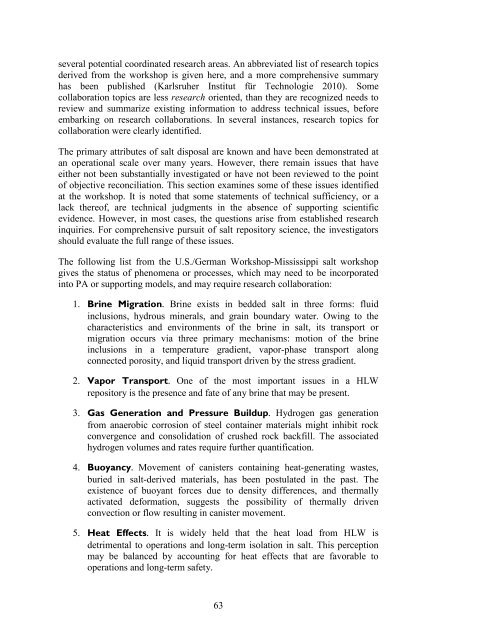Salt Disposal of Heat-Generating Nuclear Waste
Salt Disposal of Heat-Generating Nuclear Waste
Salt Disposal of Heat-Generating Nuclear Waste
You also want an ePaper? Increase the reach of your titles
YUMPU automatically turns print PDFs into web optimized ePapers that Google loves.
several potential coordinated research areas. An abbreviated list <strong>of</strong> research topics<br />
derived from the workshop is given here, and a more comprehensive summary<br />
has been published (Karlsruher Institut für Technologie 2010). Some<br />
collaboration topics are less research oriented, than they are recognized needs to<br />
review and summarize existing information to address technical issues, before<br />
embarking on research collaborations. In several instances, research topics for<br />
collaboration were clearly identified.<br />
The primary attributes <strong>of</strong> salt disposal are known and have been demonstrated at<br />
an operational scale over many years. However, there remain issues that have<br />
either not been substantially investigated or have not been reviewed to the point<br />
<strong>of</strong> objective reconciliation. This section examines some <strong>of</strong> these issues identified<br />
at the workshop. It is noted that some statements <strong>of</strong> technical sufficiency, or a<br />
lack there<strong>of</strong>, are technical judgments in the absence <strong>of</strong> supporting scientific<br />
evidence. However, in most cases, the questions arise from established research<br />
inquiries. For comprehensive pursuit <strong>of</strong> salt repository science, the investigators<br />
should evaluate the full range <strong>of</strong> these issues.<br />
The following list from the U.S./German Workshop-Mississippi salt workshop<br />
gives the status <strong>of</strong> phenomena or processes, which may need to be incorporated<br />
into PA or supporting models, and may require research collaboration:<br />
1. Brine Migration. Brine exists in bedded salt in three forms: fluid<br />
inclusions, hydrous minerals, and grain boundary water. Owing to the<br />
characteristics and environments <strong>of</strong> the brine in salt, its transport or<br />
migration occurs via three primary mechanisms: motion <strong>of</strong> the brine<br />
inclusions in a temperature gradient, vapor-phase transport along<br />
connected porosity, and liquid transport driven by the stress gradient.<br />
2. Vapor Transport. One <strong>of</strong> the most important issues in a HLW<br />
repository is the presence and fate <strong>of</strong> any brine that may be present.<br />
3. Gas Generation and Pressure Buildup. Hydrogen gas generation<br />
from anaerobic corrosion <strong>of</strong> steel container materials might inhibit rock<br />
convergence and consolidation <strong>of</strong> crushed rock backfill. The associated<br />
hydrogen volumes and rates require further quantification.<br />
4. Buoyancy. Movement <strong>of</strong> canisters containing heat-generating wastes,<br />
buried in salt-derived materials, has been postulated in the past. The<br />
existence <strong>of</strong> buoyant forces due to density differences, and thermally<br />
activated deformation, suggests the possibility <strong>of</strong> thermally driven<br />
convection or flow resulting in canister movement.<br />
5. <strong>Heat</strong> Effects. It is widely held that the heat load from HLW is<br />
detrimental to operations and long-term isolation in salt. This perception<br />
may be balanced by accounting for heat effects that are favorable to<br />
operations and long-term safety.<br />
63
















